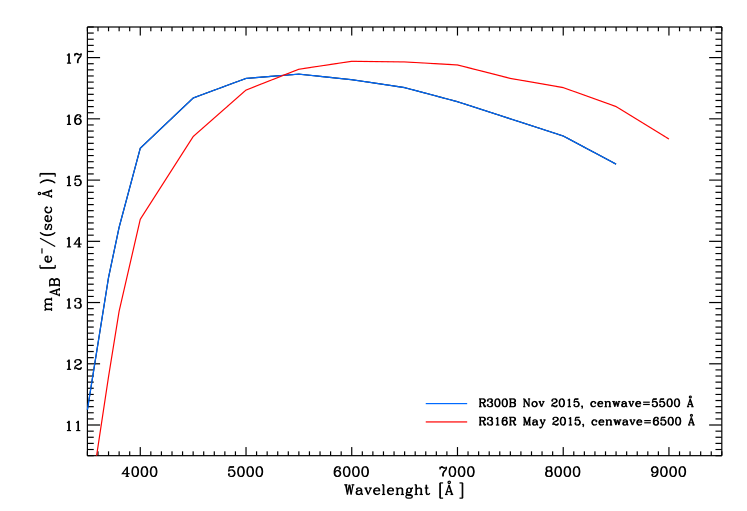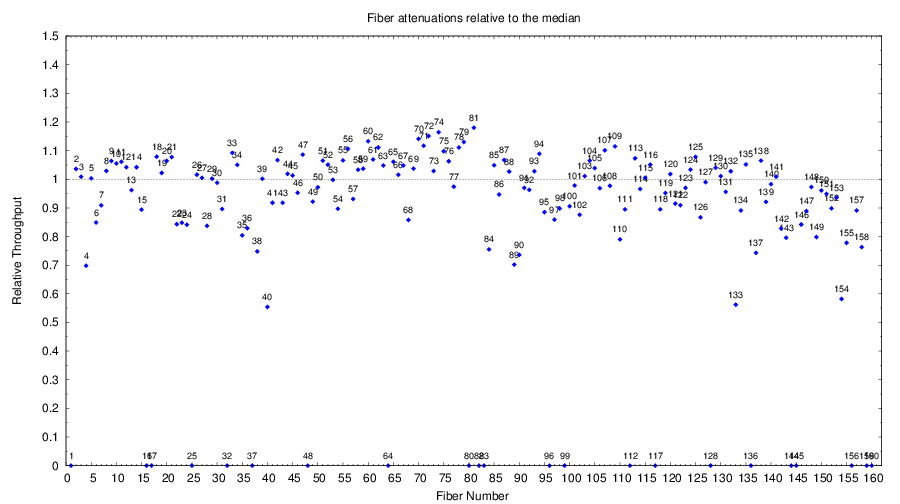Throughput
AF2+Wyffos Throughput
The throughput of AF2/WYFFOS was measured during May
and November 2015, for the following grating / CCD combinations:
R300B /
Red+4;
R316R /
Red+4 (observation of a DA0 star). The measurements were carried out after re-coating the WYFFOS fold mirror, which has greatly enhanced
the throughput in the blue (see previous throughput measurements from May 2013 here).
The table and figure below show, as a function of wavelength, the measured
mAB zeropoints, i.e. the AB magnitude of a star giving
1 electron per second per Angstrom when observed at zenith.
| Wavelength [Å] |
3800 |
4000 |
4500 |
5000 |
5500 |
6000 |
6500 |
7000 |
7500 |
8000 |
8500 |
9000 |
| R300B - Red+4 |
14.23 |
15.52 |
16.34 |
16.66 |
16.72 |
16.64 |
16.51 |
16.28 |
16.00 |
15.72 |
15.26 |
|
| R316R - Red+4 |
12.9 |
14.4 |
15.7 |
16.5 |
16.8 |
16.9 |
16.9 |
16.9 |
16.7 |
16.5 |
16.2 |
15.7 |
| Table 1:
Observed mAB zeropoint (the magnitude of a star giving 1 electron
per second per Angstrom when observed at zenith) for the whole
system: atmosphere, telescope, prime focus corrector,
AF2, WYFFOS and detector.
|
 |
| Figure 1: Observed mAB zeropoint (the magnitude of a star giving 1 electron
per second per Angstrom when observed at zenith) for the whole
system: atmosphere, telescope, prime focus corrector,
AF2, WYFFOS and detector. The red and blue curves are for
the R316R and R300B gratings respectively, with the Red+4 CCD.
The differences between the red and blue curves (measurements with
the same detector) are consistent with the known differences
in grating efficiencies.
See the text for further details. |
The mAB zeropoints have been normalized to the median fibre throughput.
Aperture correction
The above measurements were made in seeing ~ 0.7 - 0.8 arcsec
(according to the ING DIMM), and
no aperture correction has been applied; the measurements
refer to the numbers of photons entering the 1.6-arcsec apertures
of the science fibres, i.e. they will be typical of observations
of stellar objects made in this seeing, through a fibre with close
to median throughput.
The aperture correction depends on the seeing, and
on the accuracy with which the stellar image is centred on the
fibre aperture. For Moffat-profile seeing, the aperture correction can be calculated
from the
plot on the AF2 target-acquisition page.
For the measurements, the accuracy of centring
the star on the fibre was ensured to be < 0.25 arcsec by making a
spirally-rastered series of observations with step 0.5 arcsec, and using the
observation with the highest throughput (also coincident with the peak
in the distribution of intensities, i.e. not due to a short-term seeing
fluctutation). The
Moffat-profile plot shows that in seeing of 0.8 arcsec,
with a centring error of 0.25 arcsec, only a fraction ~0.04 of the light
will be missed by the 1.6-arcsec fibre aperture.
Other errors in measured zeropoint
The aperture correction probably dominates the
rms error in measuring the zeropoints,
at least in the red part of
the spectrum (wavelength > 5000 A).
In the blue, there may be additional sources of error (~ 0.1 mag)
given the rapid change of stellar
spectral energy distribution
and system efficiency (e.g. CCD QE) with wavelength.
Zeropoints for other gratings
Zeropoints for a grating Rnew
other than R316R and R316B can be obtained by
scaling the mAB magnitudes in the table according to the
relative efficiency of the AF2/ISIS
gratings using e.g.
mAB_Rnew = mAB_R316R + 2.5 x log10(Rnew/R316R)
The relative throughput of the science fibres was measured in February 2013 with the WHTWFC detector, and is plotted in
Figure 2 against
fibre number. Fibres with zero throughput are disabled, i.e. cannot be
configured for observing.

|
| Figure 2:
Throughputs of AF2 fibres, relative to the median of all fibres.
Each measurement is labelled with the fibre number.
|
The measurements were obtained with the fibres configured in a circle,
illuminated by sky, and are based on the mean observed intensity
in the wavelength range ~4200Å to 9000 Å.
The list of relative throughputs plotted
in Fig. 2 can be downloaded
from here.
More information about the fibres can be found
on the AF2 fibres page.

